
Sustainability at EQUITONE
Discover how EQUITONE is advancing its approach to sustainability through light-impact design, circular systems, radical collaboration, and full manufacturing transparency.
At EQUITONE, sustainability is more than a checkbox —it’s central to how we do business. As part of the Etex Group, a global building materials company with a diverse family of brands, we share in a companywide Road to Sustainability 2030 commitment and the six priority areas with specific science-based targets. Etex’s initiatives span multiple product lines and industries, and at EQUITONE we translate these goals into the way we design, manufacture, and deliver our fiber cement façade materials.
With over a century of material innovation behind us, we’re rethinking how facades are made, used, and reused. We know architecture must lighten its footprint on people and the planet, so our mission is clear: reduce emissions, eliminate waste, design for circularity, and empower architects to build with purpose.
While our hi-strength cement rainscreen panels are thin yet strong, material efficiency is only part of the story. Advancing light-impact construction means looking at the full lifecycle—from sourcing and manufacturing to transport, installation, maintenance, and eventual disassembly. By focusing on efficiency at every stage, we aim to help reduce overall project emissions, cut waste, and preserve resources, creating façades that perform for decades while keeping their environmental footprint as small as possible.
Our sustainable strategy starts at the manufacturing level. EQUITONE's approach is anchored in Etex's Road to Sustainability 2030 plan, which targets decarbonization, circular use of materials, and enhanced transparency across the entire company. We’ve committed to science-based goals and measure our progress against clear benchmarks. Some of our key EQUITONE-wide commitments include:
To help reach these goals, our factories run on 100% renewable electricity, operate closed-loop water systems, and source over 65% of raw materials locally to reduce transport emissions. We’re also redesigning packaging to reduce plastic use and recover shipping materials, further shrinking our operational footprint.
Learn more about Etex Group's 2030 ambitions
Being sustainable is not something we can achieve alone. That's why partnership and transparency are core to our approach. EQUITONE collaborates with suppliers on innovative raw materials (such as low-impact cement and industrial waste reuse) and works with architects, engineers and sustainability experts to explore solutions such as developing take-back systems for end-of-life panels in Europe and aligning with green building certification standards.
We hold ourselves accountable by publicly reporting our environmental impacts and obtaining independent certification. Nearly all EQUITONE fiber cement panels are Cradle to Cradle Certified® at the bronze level, and all come with Environmental Product Declarations (EPDs) documenting their life-cycle impacts. Our parent company, Etex, publishes an Annual Report that outlines sustainability goals alongside our progress towards achieving them —providing transparent updates on key targets like emissions reduction, waste minimization, and circular design initiatives. By embracing these frameworks and openly sharing both achievements and areas for improvement, we aim to avoid greenwashing and earn genuine trust.
Download our EPDs, LEED Documentation & certifications
Sustainability at EQUITONE also means delivering materials that help lighten the load for builders and the environment. Our hi-strength cement rainscreen panels are engineered for material efficiency – thin yet strong, using less raw material per square foot than many cladding alternatives while still delivering exceptional durability. Composition includes cement, mineral fillers such as sand, cellulose fibers, and water.
These attributes help reduce environmental impact through the full life cycle:
While full closed-loop recycling for fiber cement is still in development, the material naturally reabsorbs CO₂ over time – offering a modest carbon sink effect.
At EQUITONE, circular design is a team-wide commitment. From R&D to CSR, we’re rethinking materials, cutting impact, and closing the loop on façade systems. See how our leaders drive sustainable building through bold decisions, real action, and full transparency.
The construction industry is a major consumer of raw materials, responsible for:
There is resource scarcity, and there is the fact that all of the above contribute significantly to the climate crisis. Which is why we call on you to help us turn things around.
Made of water, Portland cement, cellulose and natural minerals, our materials are the perfect building blocks for a circular construction industry.
How we want to go from long life and lightweight to light impact and circular by design:

Designing our materials as a modular system that is easy to dismantle, repair and rebuild – making sure they can be reused and recycled over and over again.

Reducing our footprint across the value chain to create materials that are built to be light-impact.

Breaking down industry silos to eliminate the total footprint of our materials – not just in production, throughout their entire life cycle.
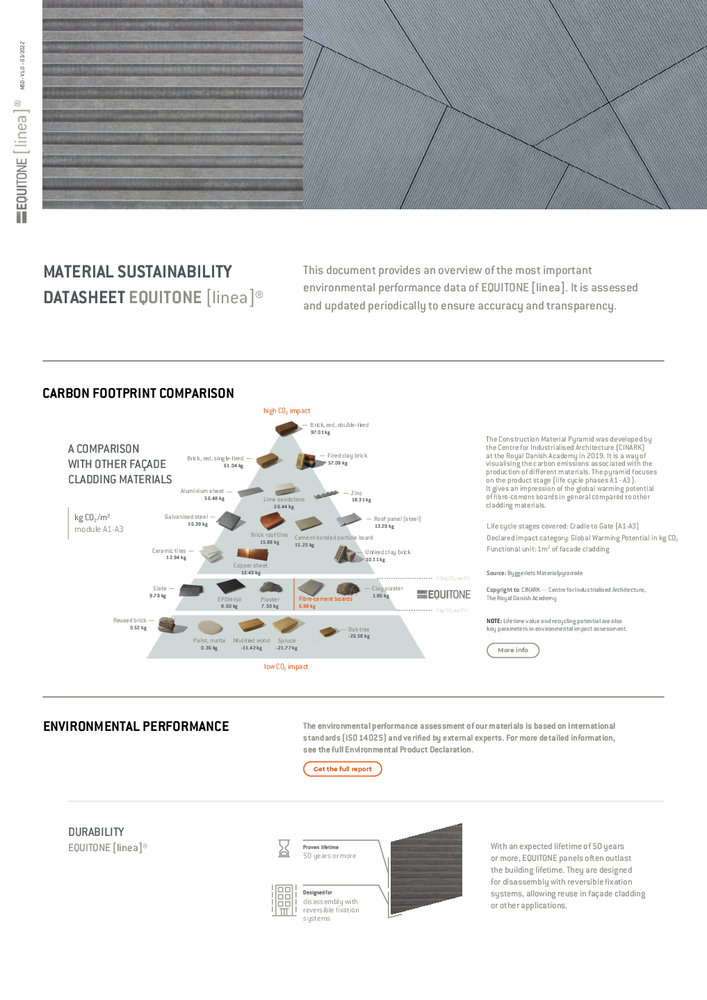
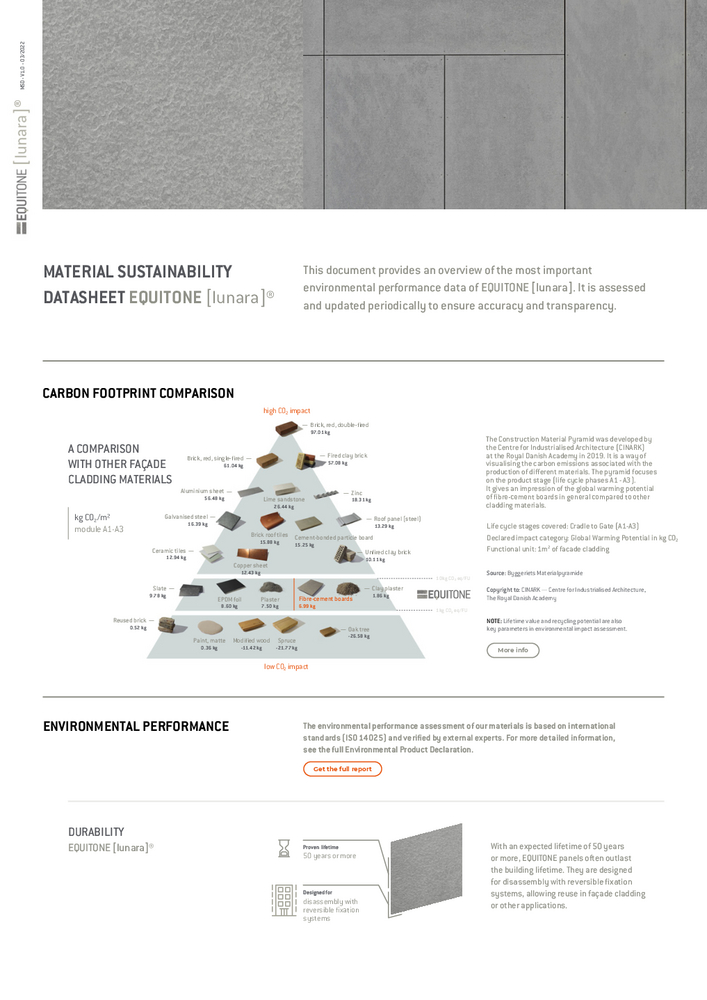
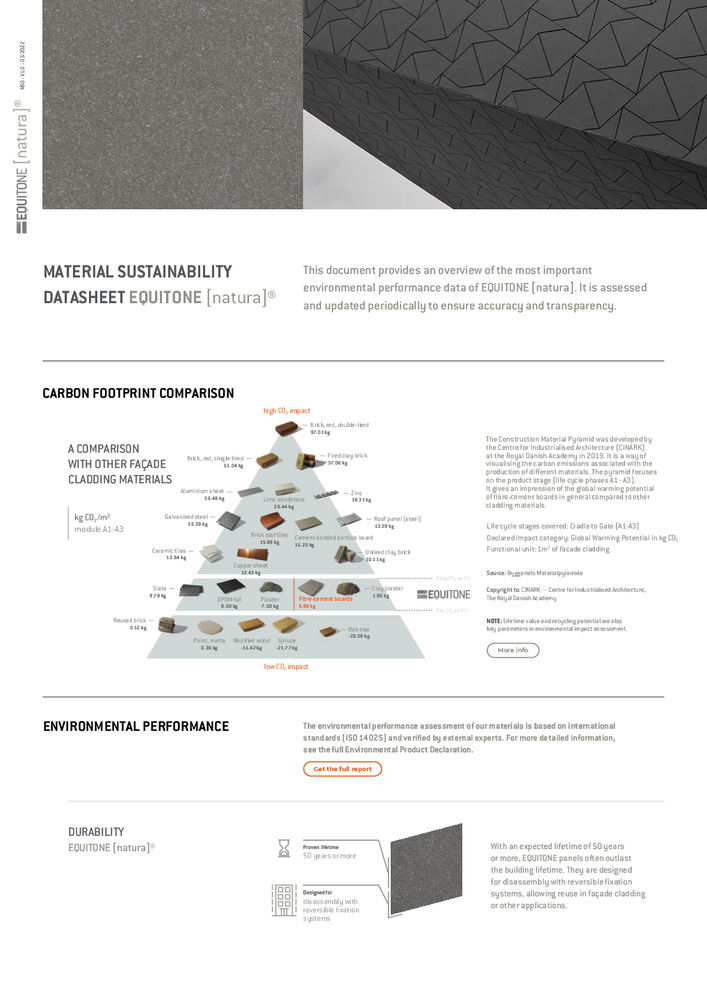
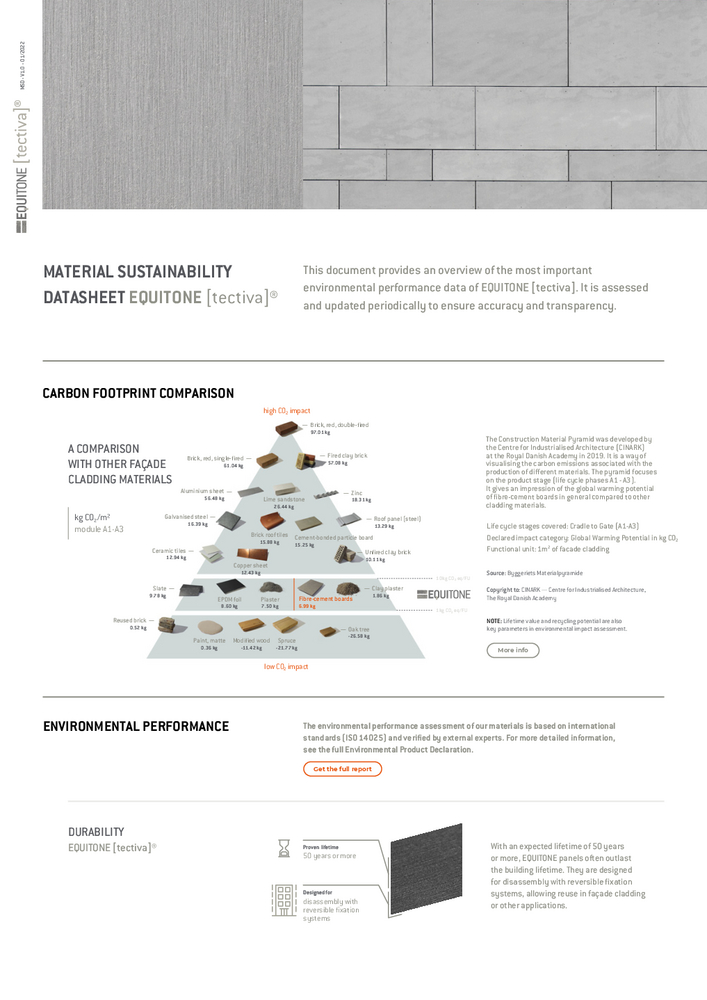
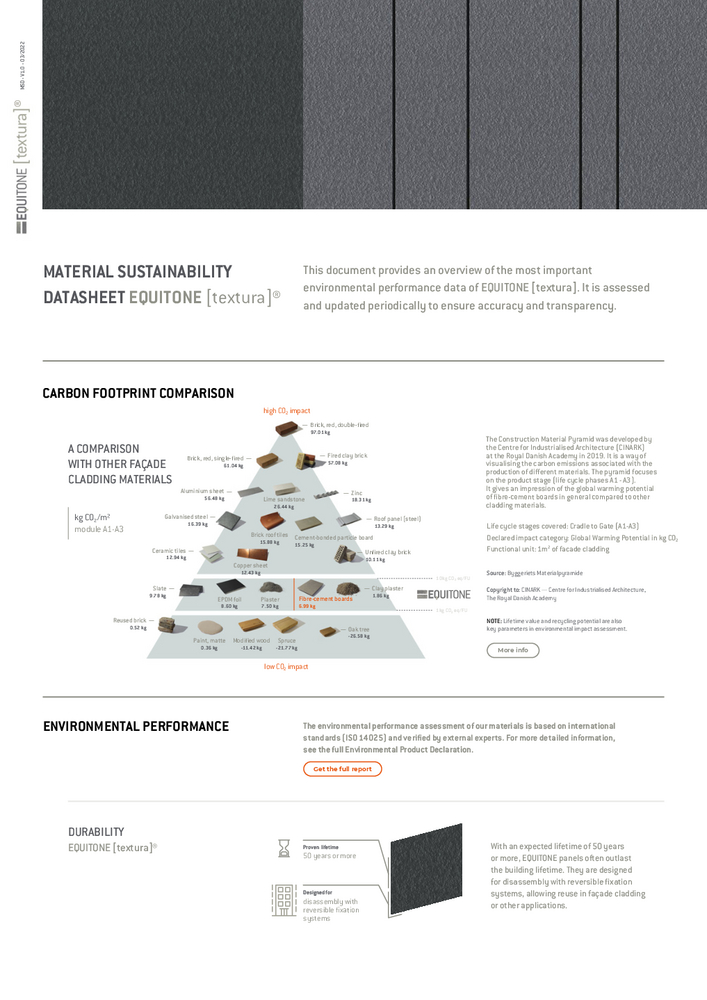
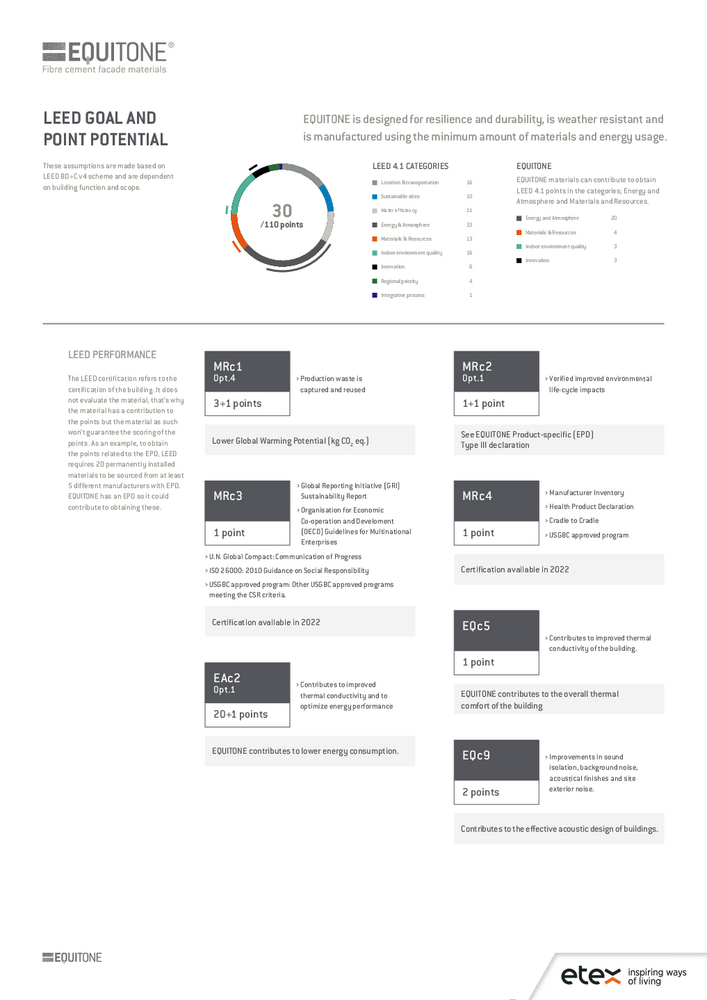
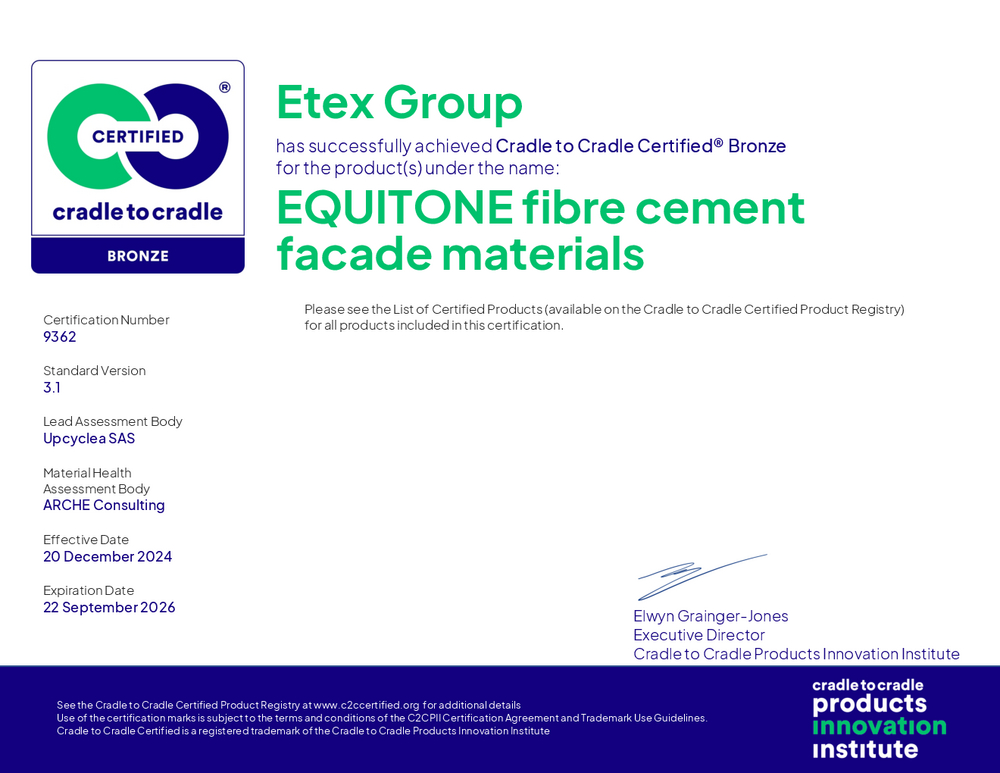
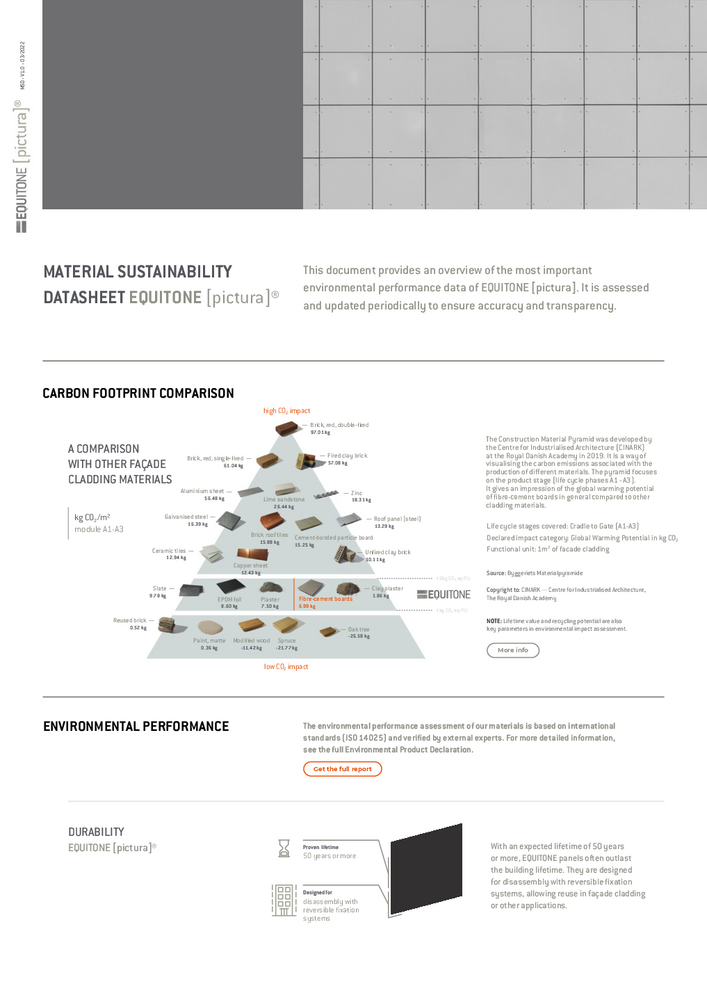
Unfortunately, we didn't find any results for your search.
![EQUITONE [tectiva] sheets](https://media.equitone.com/doc_315482_us/preview/-1532327995/tectiva_epd_b_202607_en)
![EQUITONE [pictura] / EQUITONE [natura]
PRO sheets](https://media.equitone.com/doc_315450_us/preview/-1532327995/picturanaturapro_epd_b_202607_en)
![EQUITONE [linea] and EQUITONE
[lunara] sheets](https://media.equitone.com/doc_315423_us/preview/-1532327995/linealunara_epd_b_202607_en)
![MATERIAL SUSTAINABILITY DATASHEET EQUITONE [pictura]®](https://media.equitone.com/doc_262193_us/preview/-1531941413/equitone-msd-pictura-en-us-202203)

Learn from our teammates how we are all working together to challenge the boundaries of construction.
We work together with architects worldwide to transform the built environment as we know it by completely
rethinking traditional building design.

Explore our FAQs to find everything you need to know about EQUITONE, from Cradle to Cradle certification and embodied carbon data to installation, repair, and recycling guidance.

Partner with EQUITONE to bring your sustainable façade vision to life. Our team offers product expertise, technical guidance, and circular design strategies, helping you specify façades that are durable, recyclable, and built to perform for decades.

Discover our full range of fibre cement façade panels, from [natura] and [tectiva] to [linea] and [lunara]. Compare textures, colours, and finishes, and find the perfect material for your next sustainable façade project.
Find the answer to every question ever asked about our circular ambition(s), the environmental impact of our
materials, repair and replacement instructions, you name it.

Circularity calls for collaboration. In order to eliminate the total footprint of our materials – not just in production, but throughout their lifecycle – we need to look beyond our business and develop shared solutions with stakeholders up, down and outside of the value chain.
Join our network or share your circular building designs with on Instagram at @equitone_us and #ExploringCircularity.